You Won’t Believe How Your Favorite American Dishes Look In Other Countries!
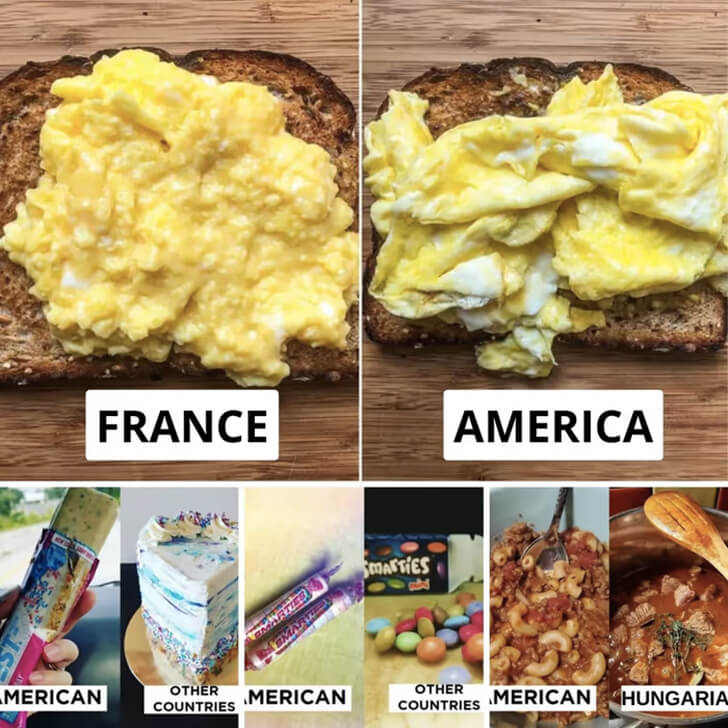
Step right up, foodies and globe-trotters alike! Imagine you’re sitting at your favorite American diner, sinking your teeth into a fluffy pancake or a juicy cheeseburger. What if we told you that the American dishes you adore might raise some eyebrows or even induce shock to someone from Tokyo or London? Oh yes, our beloved pancakes and burgers have international doppelgängers; some are wildly different from what you would expect! Intrigued?
We have scoured the culinary corners of the globe to compile a mouthwatering list that showcases American favorites in a whole new light. Buckle up because we’re diving into a world where familiar foods take unexpected twists, and you might just question everything you thought you knew about your go-to grub.
Sunny-Side Up Meets Miso
In the United States, breakfast often means eggs, bacon, and buttery toast—a hearty start designed to fuel a busy day. Across the Pacific in Japan, the morning scene shifts dramatically. Think steamed rice, grilled fish, and a bowl of miso soup, all set to invigorate the senses.
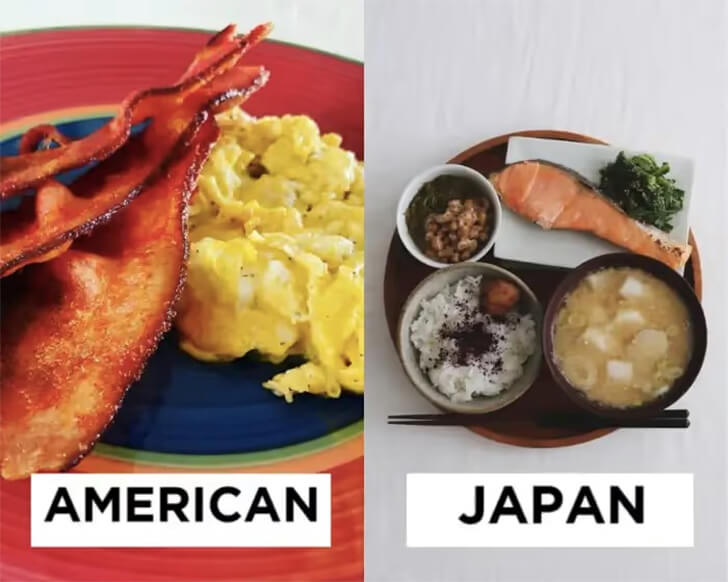
No skyscraper stacks of pancakes here; instead, a delicate spread of pickled vegetables and nori seaweed unfolds. While American breakfasts emphasize protein and fats, Japanese options lean more towards balanced nutrition with umami flavors.
A Tale of Two Chips Across the Pond
“Chips” refer to thinly sliced potatoes in the United States. These salty snacks pair perfectly with burgers or sandwiches. In contrast, the British “chips” are what Americans call “fries,” chunkier and often softer.
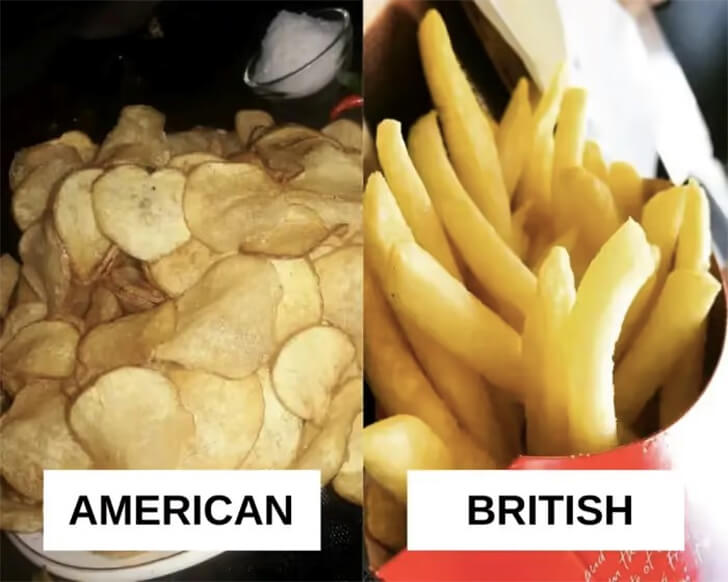
Originating from the French “frites,” these British chips accompany fish in the iconic dish “fish and chips.” The terminology confusion stems from the British term “to chip,” which means to cut or break off a small piece. While American chips offer a quick, crunchy bite, British chips provide a heartier, more robust experience.
From Spray Can to Raclette
American canned cheese emerged in the mid-20th century, initially developed for the U.S. military as a long-lasting, easily transportable food item. Known for its convenience and longevity, it has become a quirky staple in many American households.

Jump over to France, and you’ll find quite a different scenario—melted cheese traditions such as fondue or raclette dominate. These culinary practices date back to ancient times, melting high-quality, artisanal cheese to gooey perfection. While canned cheese screams convenience and practicality, French melted cheese embodies centuries of culinary finesse.
The American Dream Between Slices of Bread
The peanut butter and jelly (PB&J) sandwich is an American classic. It originated in the early 20th century, gaining popularity due to its affordability and ease of assembly—ideal for busy American lifestyles. While considered a lunchtime staple in the United States, many people outside the U.S. might find this sweet and salty combo peculiar.
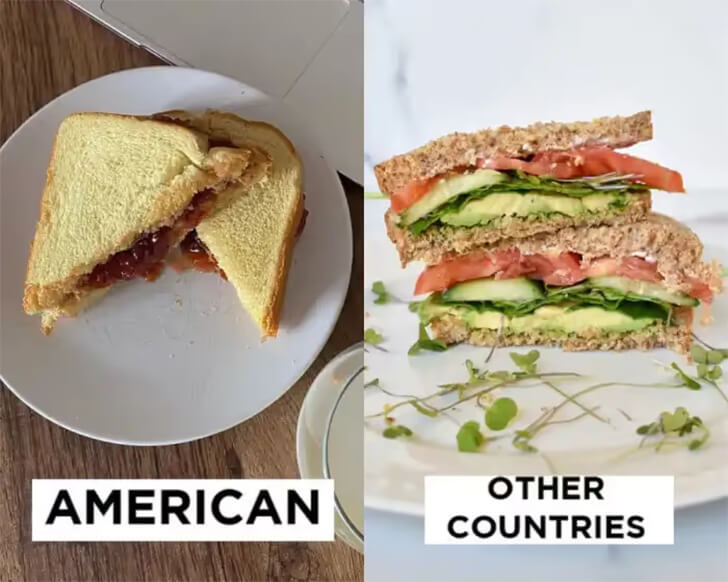
Sandwich culture thrives in America; other homegrown favorites include the Reuben and the Philly cheesesteak. The PB&J encapsulates convenience and nostalgia, symbolizing comfort food for generations of Americans.
Two Worlds, One Wok—East Meets West
American Chinese food owes its origins to early Chinese immigrants adapting traditional recipes to local palates. Often featuring sweet, fried, or sour flavors, dishes like General Tso’s chicken and crab rangoon are American creations unknown in China.
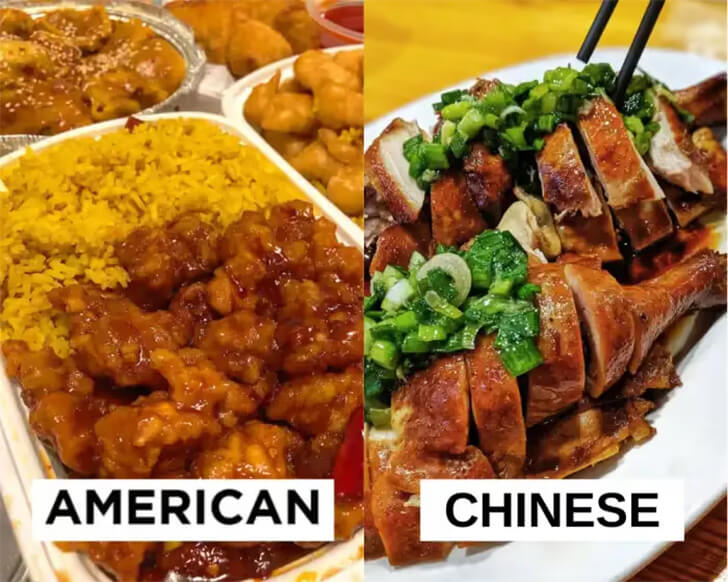
Authentic Chinese cuisine, on the other hand, is a mosaic of regional specialties—from Sichuan’s spicy offerings to Cantonese dim sum. While American Chinese food caters to comfort and familiarity, true Chinese food offers a diverse, intricate culinary landscape, making each version captivating in its own way.
Doritos and the American Flavor Export
Cool Ranch Doritos go by “Cool American” outside the U.S., primarily because ranch flavoring isn’t as universally recognized. Ranch flavor has its roots in American culinary culture, formulated in the 1950s by Steve Henson, who later commercialized it through Hidden Valley Ranch.
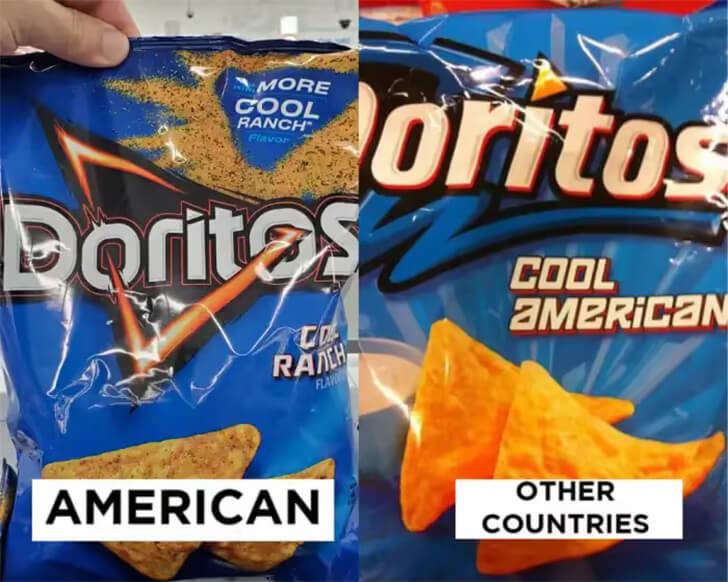
In contrast, many global palates aren’t acquainted with ranch’s tangy, herby taste. As a result, the snack was rebranded to something more universally appealing—hence, “Cool American.” While the chips themselves remain unchanged, the name swap highlights interesting nuances in culinary cross-cultural translations.
Fruit Spread Meets Gelatin
In the United States, “jelly” typically refers to a fruit-based spread, often enjoyed with peanut butter. Across the Atlantic in Britain, “jelly” is what Americans call “Jell-O,” a gelatin dessert. The linguistic confusion stems from British English, where the fruit spread Americans call “jelly” is known as “jam.”
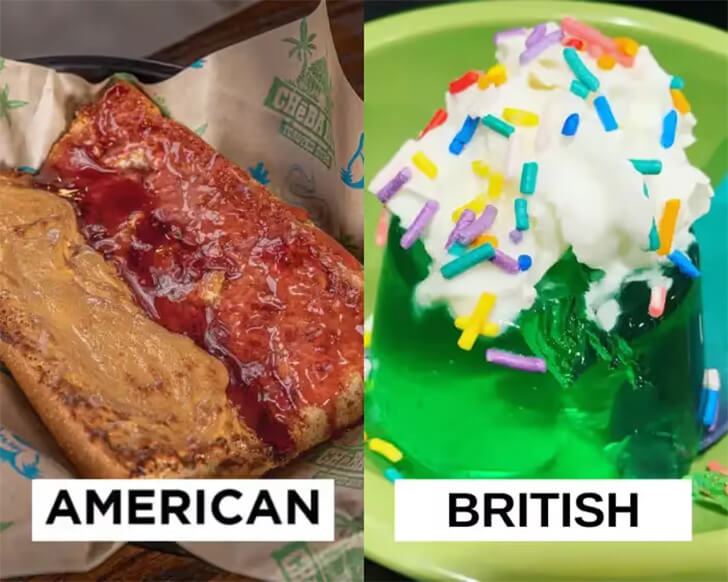
Conversely, the wobbly British jelly is termed “gelatin” or “Jell-O” in the U.S. While both jellies deliver a sweet kick, the American version highlights fruit flavors in a spreadable form, whereas the British counterpart offers a bouncy, gelatin-based treat.
Cheesy Divide—Disco vs. Poutine
Disco fries and poutine are North American cousins with distinct personalities. Originating in New Jersey diners, disco fries feature crispy fries smothered in gravy and melted cheese—usually mozzarella. Poutine, a Canadian staple born in rural Quebec, elevates the experience with cheese curds and a thicker gravy.
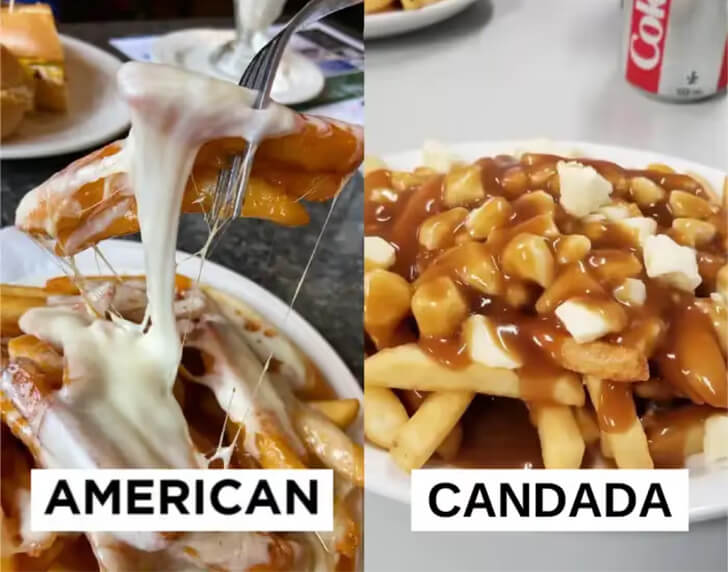
While disco fries have a smoother, more uniform cheese layer, poutine boasts a chewy, squeaky texture from its curds. Both dishes serve as comfort food and late-night cravings, yet each tells a different story of culinary tradition and regional pride.
Wrapped or Rolled Sandwich
Subway sandwiches, a hallmark of American fast food, feature a long roll filled with various meats, cheeses, and vegetables. In other countries, this style of sandwich may not be as ubiquitous. Wraps, which use a flatbread to encase similar fillings, offer an alternative.
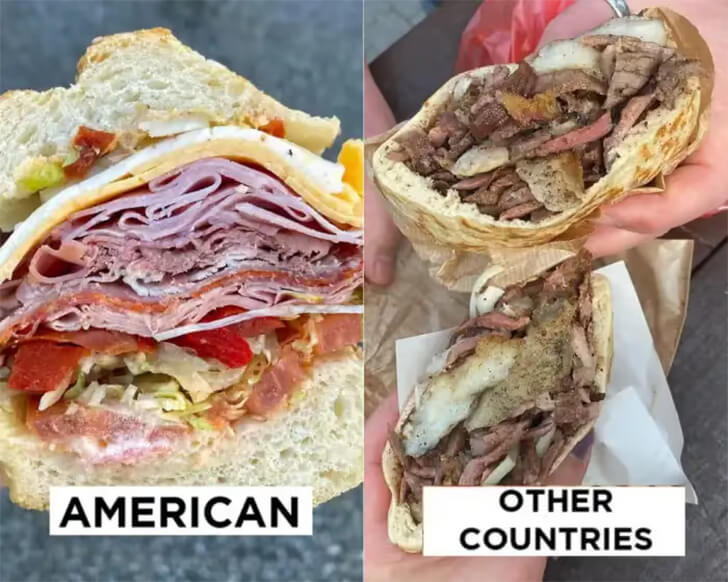
Though wraps have gained popularity due to perceived health benefits, Subway sandwiches still maintain a strong following. While the ingredients may overlap, the experience diverges: subs offer a hearty, crusty bite, whereas wraps present a softer, more cohesive texture.
The American Love for Birthday Cake Flavored Goodness
In the U.S., “birthday cake flavor” transcends the cake itself, infusing a myriad of treats from ice cream to protein bars. This flavor replicates the buttery vanilla cake, swirled with frosting and often accented by rainbow sprinkles.

While other countries primarily celebrate with traditional cakes, the U.S. has commercialized the flavor, turning it into a nostalgic taste experience available year-round. The trend started with the advent of cake-flavored vodka in the early 2010s, and from there, the birthday cake taste has spread faster than candlelight on a cake!
A Hamburger Cultural Exchange
While American hamburgers focus on layers—beef patty, lettuce, tomato, and various condiments tucked between buns—Japanese hamburgers often appear as “hambāgu,” a patty served without buns and glazed with a rich sauce. The American version has its roots in early 20th-century fast food, becoming a symbol of American culture.
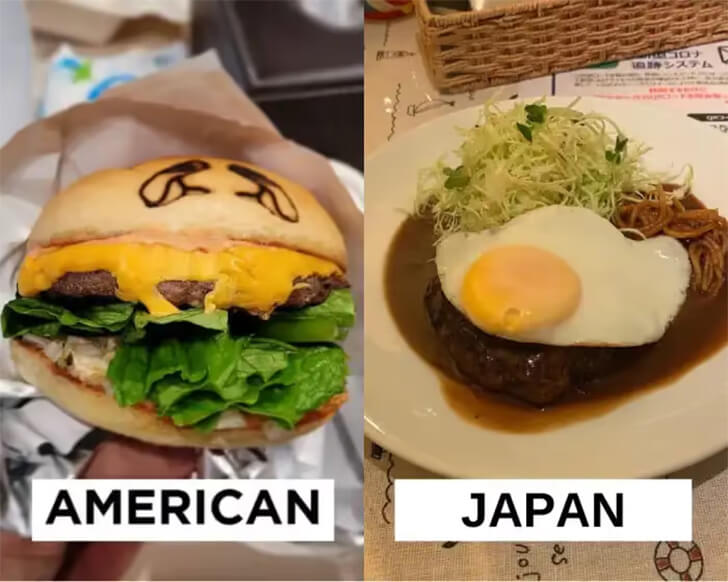
Conversely, “hambāgu” emerged in post-war Japan, inspired by Western cuisine but adapted to local tastes. Both versions share a love for quality beef but diverge in presentation and accompaniments, making each a unique culinary experience.
Cinnamon Swirls Across Borders
American cinnamon rolls are often gooey, large, and slathered in cream cheese frosting, while their Swedish counterparts, known as “kanelbullar,” are more modest in size and sweetness. Both versions feature a dough swirled with a cinnamon-butter mix, but “kanelbullar” incorporates cardamom in the dough for a unique twist.
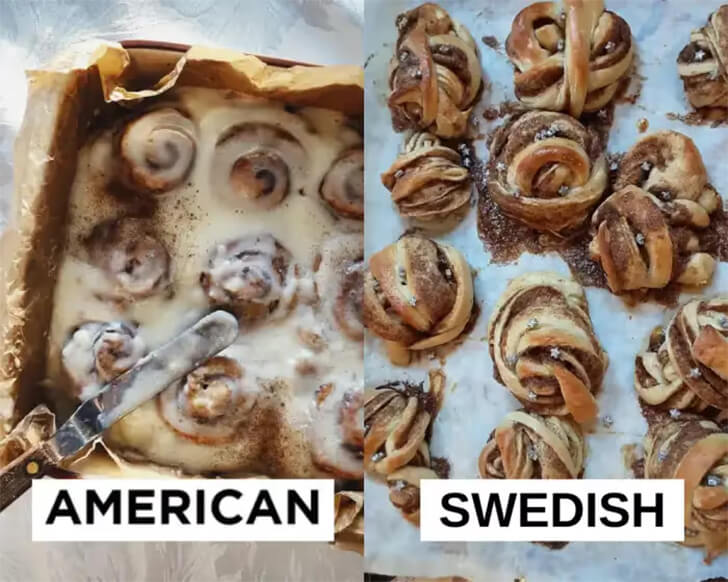
Additionally, “kanelbullar” often comes adorned with pearl sugar instead of frosting, offering a more understated sweetness. Each version reflects its culinary landscape: the American take leans into indulgence, while the Swedish variety embraces nuanced flavors and textures.
Two Pigs, Two Blankets
On both sides of the Atlantic, “pigs in a blanket” conjure up images of meaty morsels swathed in dough. However, the details diverge considerably. In America, these typically consist of mini hot dogs or sausages enveloped in crescent roll dough, often enjoyed as a snack or appetizer.
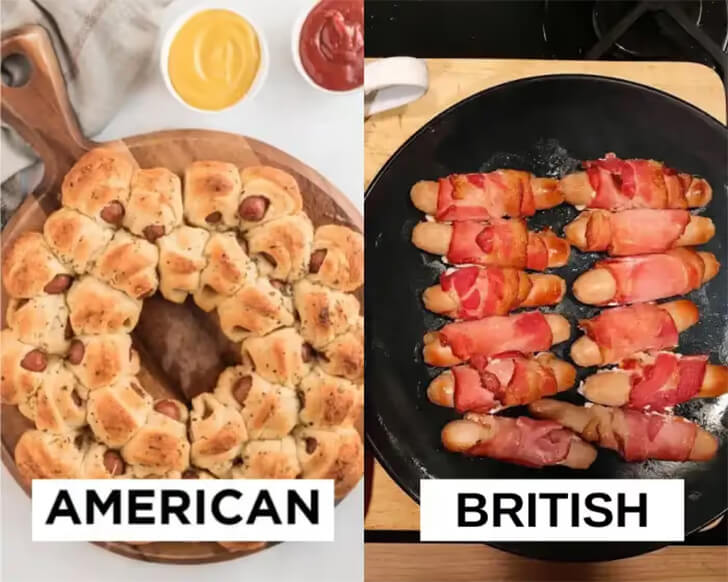
Across the pond in Britain, the dish refers to small sausages wrapped in bacon, commonly served as a side during traditional holiday meals. While both share the concept of meat encased in a “blanket,” the ingredients and occasions they grace make them unique.
The American Crime on Carbonara
American carbonara often gets its creaminess from an added dash of heavy cream, a deviation that would make Italian grandmothers wince. Authentic Italian carbonara employs a simple blend of pasta, pancetta, Pecorino Romano, and a raw egg mixed to creamy perfection without a drop of cream.
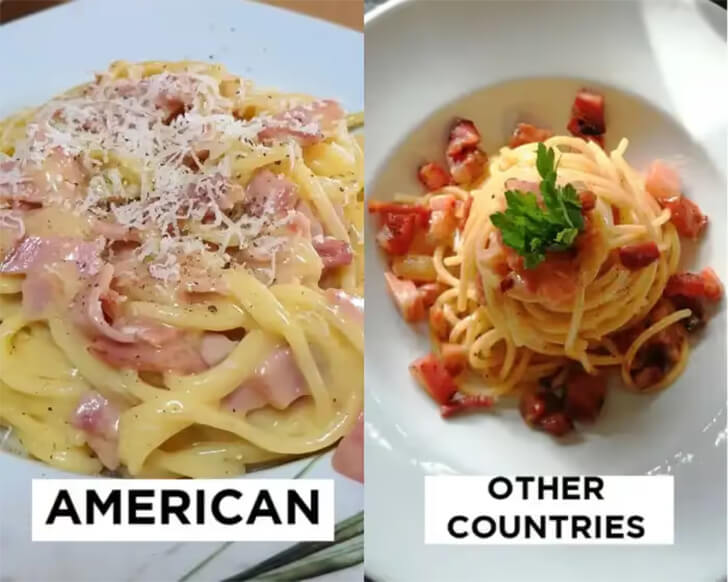
The American addition likely stems from a desire for a richer, saucier experience, breaking away from the minimalist Italian tradition. Although these two versions have their merits, the difference highlights how one dish can undergo a transformation when it crosses cultural boundaries.
Why Ice is American?
Iced drinks are almost a rite of passage in the United States, especially during sweltering summers. But if one ventures outside the U.S., icy beverages are far less common. In some European and Asian cultures, it’s believed that cold drinks can disrupt digestion.

Hot tea is the standard in places like China, even on hot days, due to traditional medicinal beliefs. Additionally, concerns about water quality make ice a risky proposition in some countries. So, while Americans revel in their icy refreshments, other cultures remain lukewarm to the idea.
Shell Game—The Taco Divide!
American tacos and Mexican tacos may share a name, but their ingredients often tell different stories. In the U.S., hard-shell tacos filled with ground beef, lettuce, and shredded cheese are popular. By contrast, Mexican tacos usually feature soft corn tortillas cradling fillings like carne asada or al pastor, adorned with cilantro and onions.
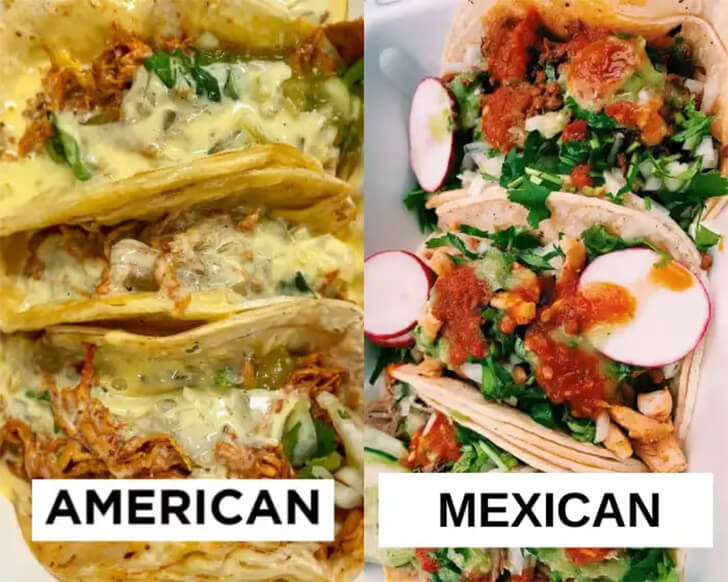
Forget the sour cream and shredded cheddar; Mexican tacos opt for crumbled queso fresco and perhaps a squeeze of lime. Each version is delicious in its own right, but they showcase different culinary traditions and priorities.
The Croissant’s Americanized Transformation
In the United States, croissants have been recruited into sandwich service, often stuffed with eggs, cheese, or deli meats. But don’t expect this culinary combo in France, where the croissant remains a sacred solo act, enjoyed primarily at breakfast and perhaps lightly adorned with a smear of jam or butter.

For the French, the flaky layers and buttery richness are indulgent enough without the distraction of sandwich fillings. The American innovation reflects a penchant for reinventing classics to create something both familiar and novel.
French Dressing Unbottled
American French dressing and its French counterpart may share the word “French,” but they’re as different as, well, French fries and pommes frites. Stateside, French dressing is a ketchup-based concoction with a sweet-tangy profile, tinged orange by the addition of paprika and other spices.
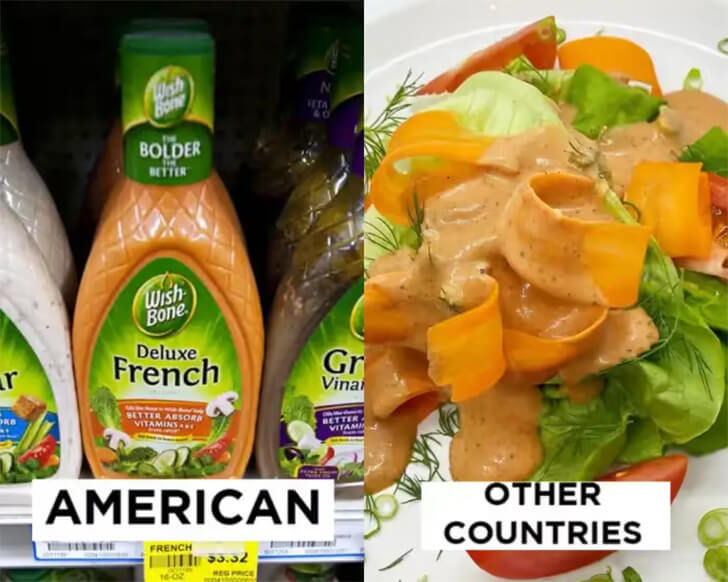
In France, however, “French dressing” isn’t even a term! They’d opt for a simple vinaigrette made from oil, vinegar, mustard, and seasoning. The American version has its roots in mimicking fancier European cuisines, while the authentic French version sticks to tradition and simplicity.
The Bacon Diaries: Crispy vs. Streaky
Bacon—it’s a breakfast staple on both sides of the Atlantic, but don’t mistake one for the other. In America, bacon generally comes from pork belly, resulting in long, streaky, fatty strips that crisp up when cooked.

Across the pond in Britain, bacon is cut from the loin on the back of the pig, leading to leaner, meatier slices often referred to as “back bacon.” While both versions have deep-rooted cultural histories tied to their respective culinary landscapes, each offers its own unique texture and flavor experience.
Toppings Around the World
American pizza tends to stick with familiar toppings: pepperoni, sausage, mushrooms, and the like. But venture abroad, and it’s a whole different ball game. Japan enjoys pizza topped with squid and mayonnaise. Down under in Australia, kangaroo and emu make their appearances. And let’s not forget Sweden’s banana curry pizza!
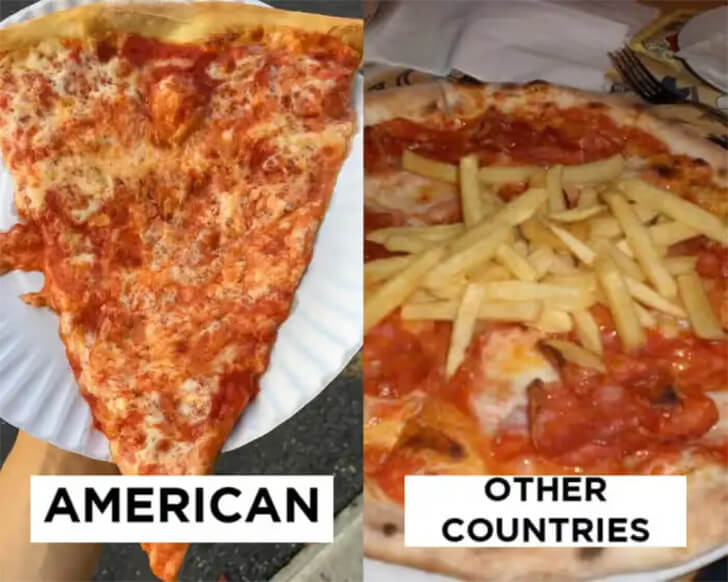
Each country customizes this universally loved dish to local tastes, creating a myriad of surprising combinations. So, while Americans cherish their extra cheese, the rest of the world is slicing up tradition with delectable flair.
American Twist vs Hungarian Tradition
American goulash and its Hungarian counterpart share little more than a name and meaty goodness. The Hungarian version, a hearty stew, boasts paprika-laden beef and a rich broth. Meanwhile, the American twist leans into comfort food territory, blending ground beef with elbow macaroni and a tomato-based sauce.

Why the pasta? Likely a nod to American love for easy, one-pot dishes that feed a crowd. Each dish reflects its cultural backdrop: one steeped in Old World traditions and the other embracing New World practicality.
From Hong Kong Streets to American Eateries
American and Hong Kong waffles both turn batter into edible works of art yet diverge dramatically from there. American waffles are generally denser and are often paired with fried chicken, a combination that surprisingly melds savory and sweet. Meanwhile, Hong Kong waffles sport bubbly, hexagonal patterns and skew sweet or savory as street snacks.

The chicken-waffle duo hasn’t caught on globally as an iconic pair, suggesting its uniquely American appeal. Whether it’s the heft of an American waffle or the airy charm of a Hong Kong version, both are tasty.
The Sizzle Behind Fajitas
Fajitas, with its sizzling charm, has a unique story that spans borders. Originating in Texas, the dish originally featured grilled skirt steak, which translates to ‘faja’ in Spanish, hence the term ‘fajita.’ However, in the U.S., the term has expanded to include chicken, shrimp, and even vegetarian options.
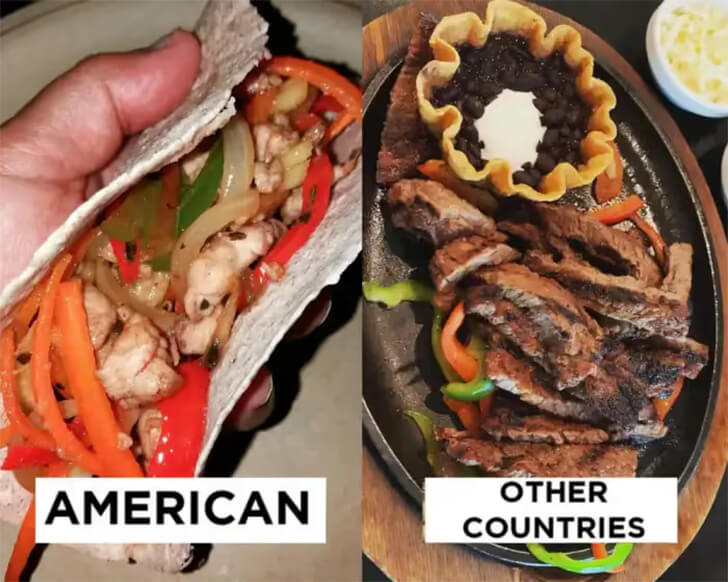
In contrast, other countries often stick to the traditional beef-centered version, making the American interpretation a diverse culinary playground. It’s fascinating how a simple dish can evolve and take on new identities as it travels.
Pre-Packaged Art For Instant Gratification
Let’s slurp into the topic of ramen—American instant versus authentic Japanese. Japan gifted the world with this culinary marvel, where every bowl is an art form. It’s all about broth, noodles, and carefully selected toppings.
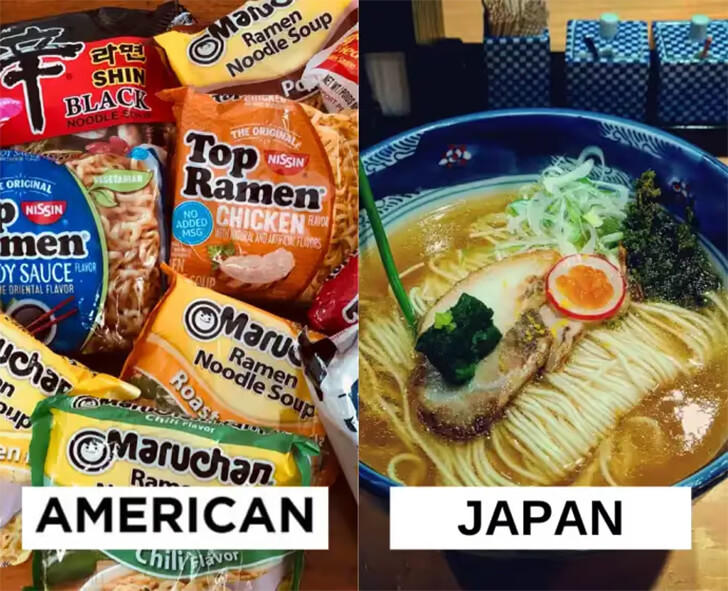
Meanwhile, America embraced the instant version, thanks to Momofuku Ando’s ingenuity in creating pre-packaged noodles in the late 1950s. Today, instant ramen is a pantry staple in U.S. households. Why? Because it offers quick satisfaction. However, it lacks the depth of Japan’s traditional dish. It’s like comparing a snapshot to a masterpiece.
Same Name, Different Game
Feeling the need for something sweet? Let’s unwrap the candy conundrum of Smarties. In the United States, Smarties are tart, chalky disks created by Edward Dee in 1949. Across the pond, Smarties are candy-coated chocolate buttons launched by Rowntree’s in 1937.

American Smarties boast a powdery burst of tangy fruitiness, while their British counterparts bring creamy chocolate goodness in a vibrant shell. Two different countries and two different candies, but share one name. Call it a sugary case of mistaken identity.
Rolling from East to West
Sushi is the epitome of culinary art, yet its American and Japanese versions are as distinct as night and day. In Japan, sushi is an elevated craft, focusing on the freshness of fish and the delicate flavor of vinegared rice.
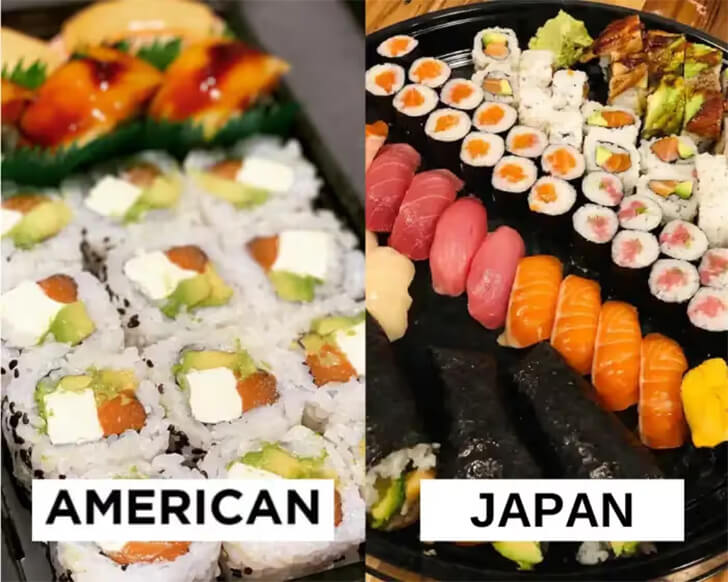
Americans, however, have jazzed it up with unorthodox ingredients like cream cheese and fruits, giving birth to creations like the Philly roll. While traditionalists might scoff, these American twists have made sushi accessible and endlessly inventive. Two worlds, one dish, and a smorgasbord of flavors.
American Cheese Melts Away Tradition
When it comes to cheese, America marches to the beat of its own drum. Known for its processed, easy-melting attributes, American cheese is often snubbed by international cheese aficionados. In contrast, countries like France and Italy are renowned for their aged, artisanal cheeses rich in tradition and complexity.
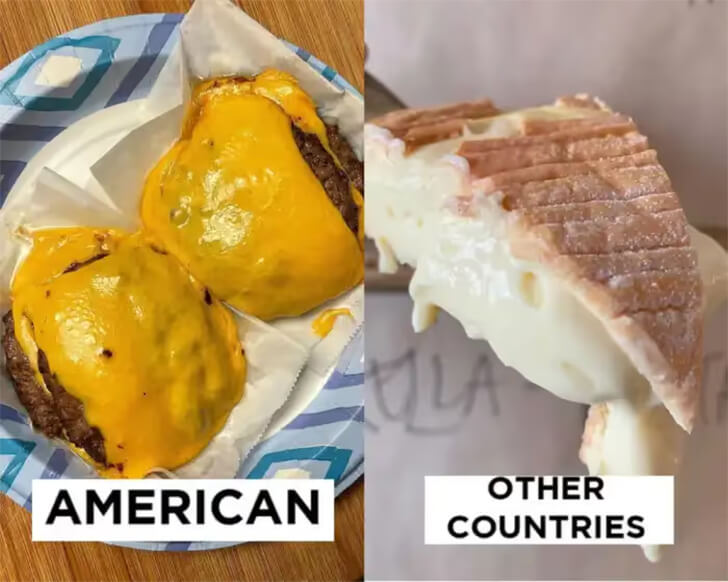
But let’s not dismiss the American staple—its creaminess and meltability make it a fast-food favorite. So, whether it’s a gourmet French Camembert or a slice of good ol’ American, cheese unites taste buds worldwide.
Steeped in Different Tea Cultures
A cup of tea is not just a cup of tea. In America, iced tea reigns supreme, often loaded with sugar or fruit flavors. Across the pond, the British cherish their hot tea, a refined affair complete with rituals and milk.
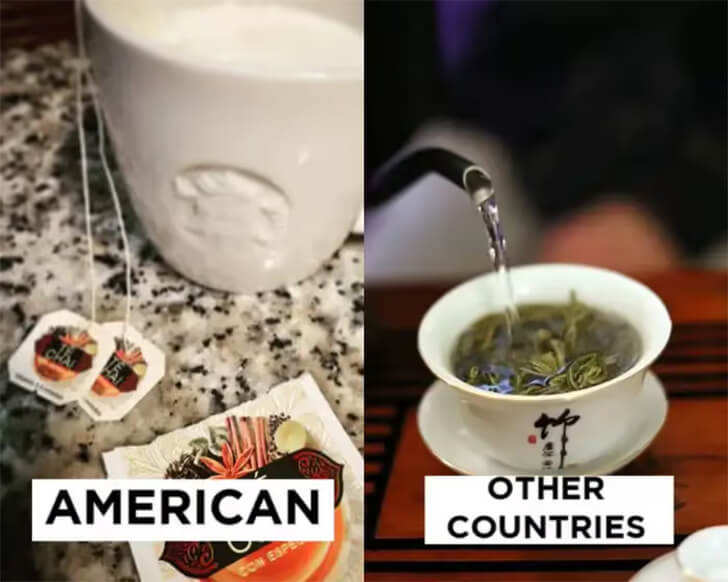
Move east, and there’s the intricate Japanese tea ceremony, elevating Matcha to an art form. While green tea is the cornerstone of China’s tea culture, loaded with antioxidants and tradition. Yes, one plant—Camellia sinensis—can manifest so differently based on geographic and cultural interpretations.
From Saigon Streets to American Eateries
Though they share a name, the American banh mi and its Vietnamese counterpart are cousins, not twins. Originating in Vietnam, the authentic banh mi balances savory, sweet, and spicy in a French baguette filled with pate, pork, pickled vegetables, and cilantro.
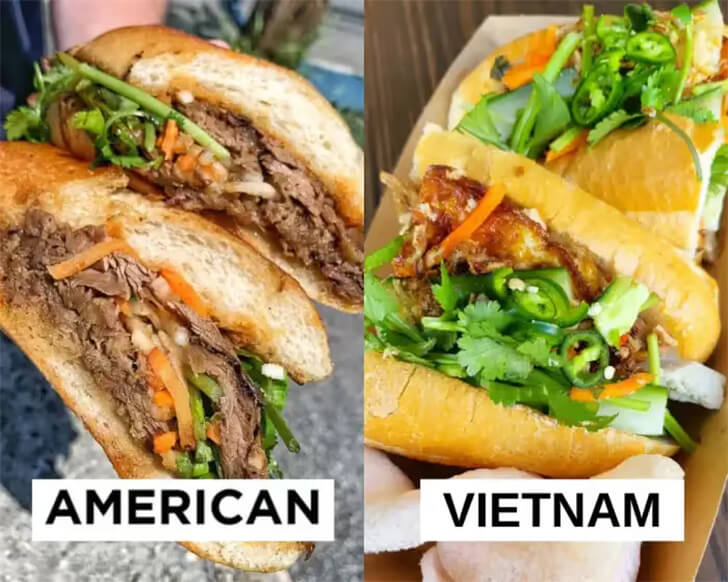
In contrast, the American version jazzes it up with trendy ingredients like sriracha mayo or avocado. It’s not uncommon to find smoked turkey or even tofu between the slices. Despite these differences, both versions honor the spirit of fusion, each a sandwich that bridges worlds.
S’mores vs. Schokoküsse: A Sweet Culture Clash
American s’mores, born from campfire tradition, have graham crackers, a layer of chocolate, and a toasted marshmallow. Their German counterpart, “Schokoküsse,” consists of a dollop of marshmallow-like foam coated in chocolate. The primary difference lies in the marshmallow.

The marshmallows from the U.S. are typically denser, making them ideal for toasting, whereas the German foam is lighter and airier. Each treat encapsulates the essence of its origin: s’mores capture the rugged outdoor spirit of America, while “Schokoküsse” reflects German precision in confectionery.
America vs. Japan on Sushi Etiquette
Wasabi and pickled ginger serve specific roles in Japan: wasabi is lightly placed between the rice and fish, while ginger is eaten between different types of sushi to cleanse the palate. Americans often commit sushi faux pas by mixing wasabi into soy sauce and piling ginger atop their sushi rolls.
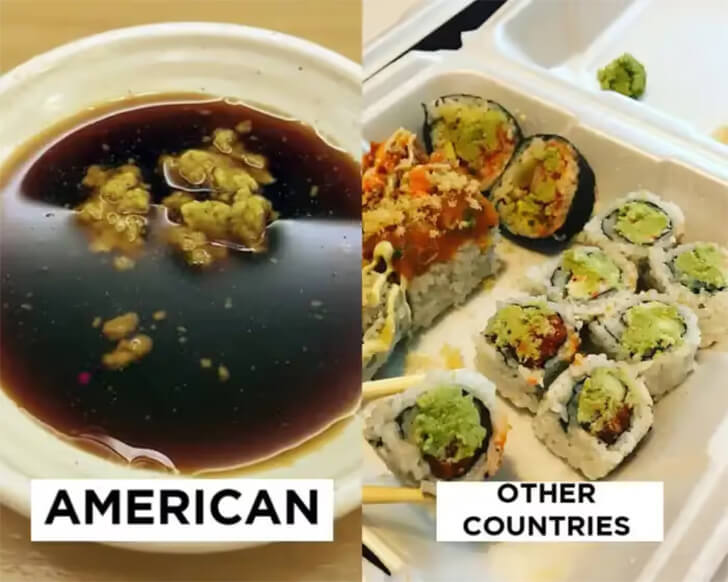
This amalgamation creates a flavor explosion that somewhat detracts from the delicacy of the sushi itself. Whether considered culinary creativity or an etiquette misstep, this practice highlights the cultural differences in enjoying this popular dish.
Breaking Breadsticks—American vs. Global Breadsticks
Breadsticks in the U.S., often slathered in garlic butter, are far from Italy’s “Grissini,” which are thin and crisp. The American version often accompanies pizza and is generally soft and doughy, a transformation likely influenced by pizzerias.
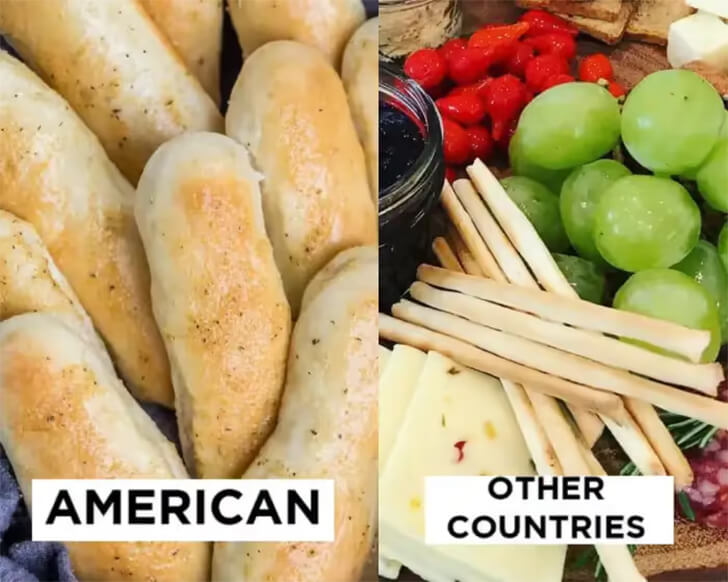
On the other hand, Grissini has roots in 17th-century Turin and was originally developed as a digestible bread for the Duke. While Grissini is served as an appetizer in Italy, American breadsticks have become a staple in casual dining, each reflecting their respective culinary landscapes.
From Meatballs to Hotdogs—Spaghetti Rebooted
While American spaghetti often stars robust meatballs in a tomato-based sauce, its Filipino counterpart turns heads with sliced hotdogs and ground meat. Why the difference? The American classic owes its heritage to Italian immigrants, aiming to recreate an old-world recipe with the meaty goodness of meatballs.
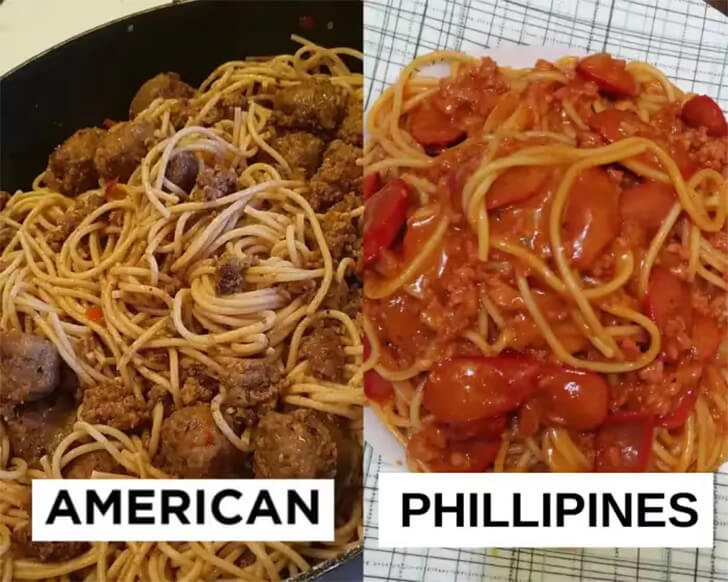
Meanwhile, Filipino spaghetti reflects an amalgamation of cultural influences, notably American. It features a sweeter sauce and, instead of meatballs, embraces hotdogs—a lasting impact of American occupation. Each version is a gastronomic diary, narrating its own tale of cultural fusion.
Uniting Over Cheese Splits
Americans treasure their grilled cheese sandwiches—buttery, toasted slices of bread embracing a molten core of cheese, often served alongside tomato soup. Across the pond, the British have a different take, known locally as a “cheese toastie.”
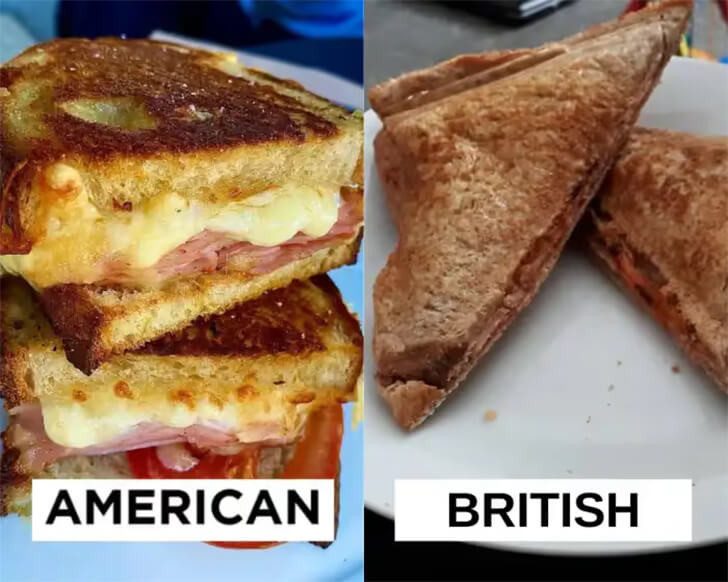
This British staple involves grilling the bread and cheese together in a sandwich press or panini grill. The Brits also add adventurous fillings like chutney, tomatoes, and onions. Though they share a common love for melted cheese, the sides of the Atlantic deliver this gooey delight with their own local twists and traditions.
Sweet and Savory Spud Takes
Americans have a penchant for transforming their potatoes into an array of forms—mashed, fried, baked—you name it. Come Thanksgiving, sweet potatoes take center stage, often jazzed up with marshmallows and brown sugar. Meanwhile, Koreans also relish their potatoes but in a different manner.
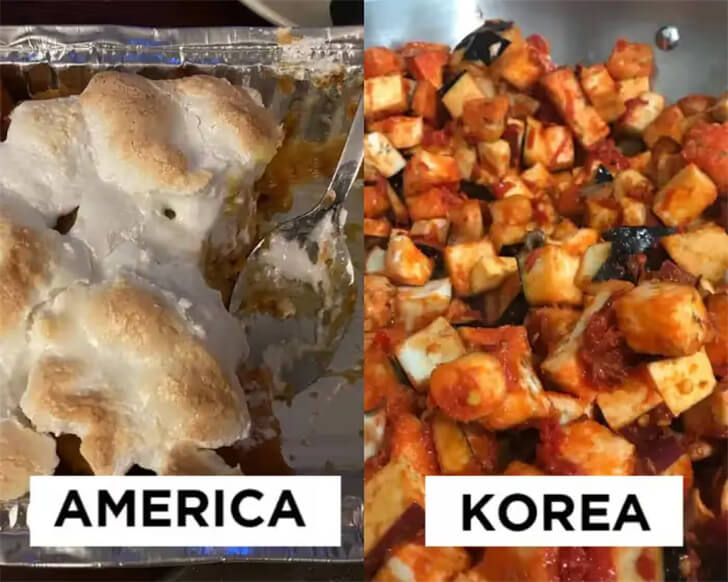
Typically, potatoes are used in stews or as banchan, a side dish often seasoned with soy sauce, garlic, and sesame oil. For a sweeter touch, Korean cuisine offers “matang,” glazed sweet potatoes caramelized in sugar and soy sauce. Two nations, diverse potato expressions!
Pho-tastic Journey from Vietnam to America
Along the bustling streets of Hanoi, Vietnam, pho simmers in giant pots, its aroma filling the air. Authentic Vietnamese pho is a masterful blend of bone broth, rice noodles, and a bouquet of spices like star anise and cloves.
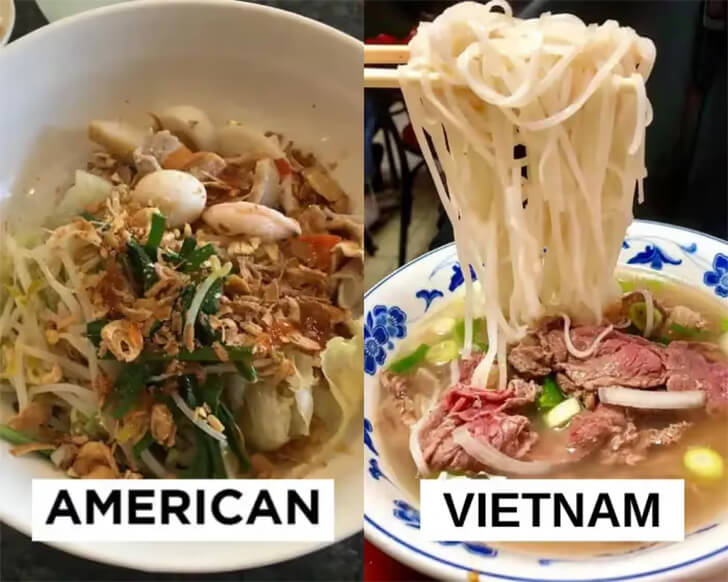
Meanwhile, in the United States, pho has found a new home but with a twist—think sriracha splashes and non-traditional meats. While the essence remains, the American adaptation sometimes veers off the authentic course, making it a fascinating culinary case of East meets West.
Loafing Around U.S.A.
Often found pre-sliced and soft, American loaf bread has long been a household staple. Yet, stroll through international supermarkets, and it’s a world of hearty sourdoughs, French baguettes, and Italian ciabattas. These breads have carved their own niche in the U.S., but often with a twist to suit local palates.
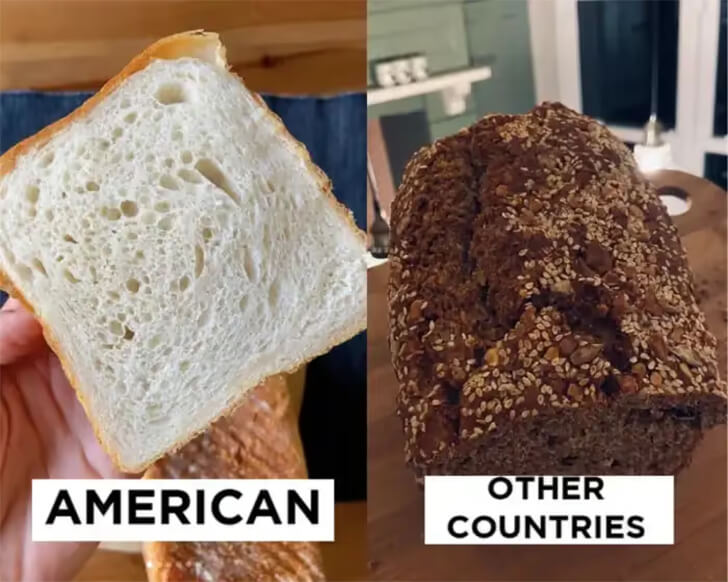
While the versatile American loaf wins on convenience, some global critics find it lacks the character and texture of its international counterparts. It’s a loaf-lover’s world, and each slice tells its own story.
The Cereal Gap Across the Atlantic
A bowl of cereal may seem universal, but dig deeper, and transatlantic differences emerge. American cereals often have a sugary reputation, thanks to the love for vibrant, sweet flavors. It’s a taste profile built on cultural tradition and clever marketing.
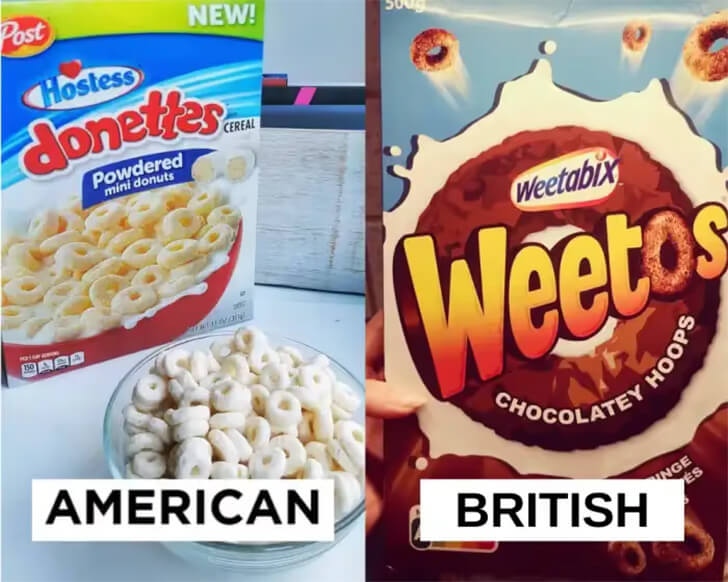
In contrast, British cereals lean toward the conservative, focusing on whole grains and lower sugar content, guided by stricter food regulations. Two nations, separated not just by an ocean but also by their breakfast choices, showcase cereal philosophy in every spoonful.
Mac Meets Älplermagronen
Mac and cheese, an American classic, is often made with elbow pasta and a melty cheddar sauce, a staple dish born from resourcefulness and wartime rationing. Meanwhile, Switzerland’s “älplermagronen” elevates the concept with additions like caramelized onions and crispy bacon, accompanied often by apple sauce.
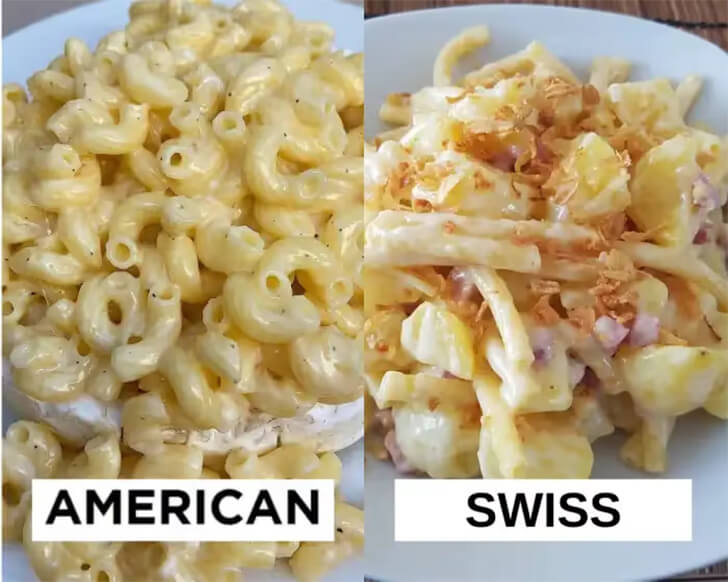
This dish, hailing from the Swiss Alps, offers complex flavors while using local ingredients like Gruyère. Both are comfort foods in their respective nations, but while one aims for simplicity and affordability, the other seeks to incorporate rich Alpine flavors into every bite.
British Cookies, American Fluff
Biscuits are flaky, buttery concoctions often served alongside fried chicken or gravy in the United States. Meanwhile, beyond the Atlantic, British biscuits bear resemblance to what Americans dub “cookies,” crispy and sweet, perfect for tea-dunking. The American version, a Southern staple, evolved as a quick, hearty addition to meals.
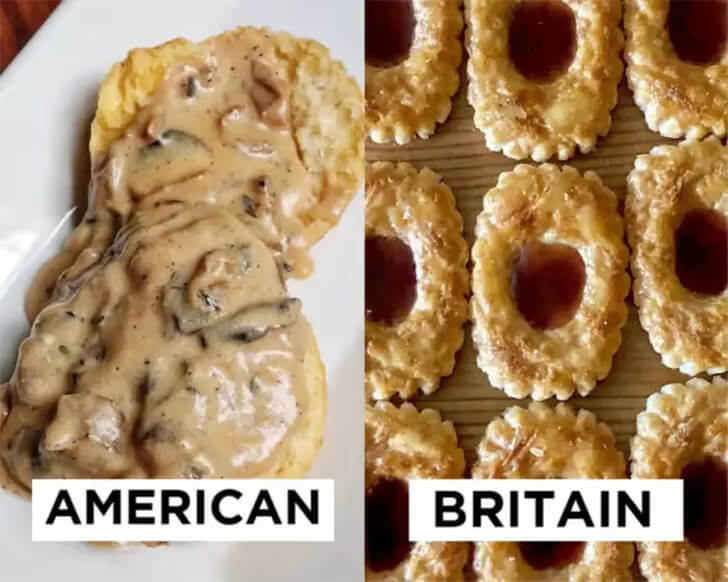
On the British side, biscuits like Digestives and Jammie Dodgers have tea-time significance, shaping social rituals. While the terminology might be confusing, both countries savor their respective biscuits as essential comfort foods.
Brits Go Flat While Americans Puff Up
American pancakes are the fluffier cousins of their British counterparts, thanks to the generous use of baking powder in the batter. These stacks of airy goodness often come adorned with butter, syrup, or a fruit topping. On the other hand, British pancakes closely resemble what the French call crêpes—thin and slightly crispy at the edges.
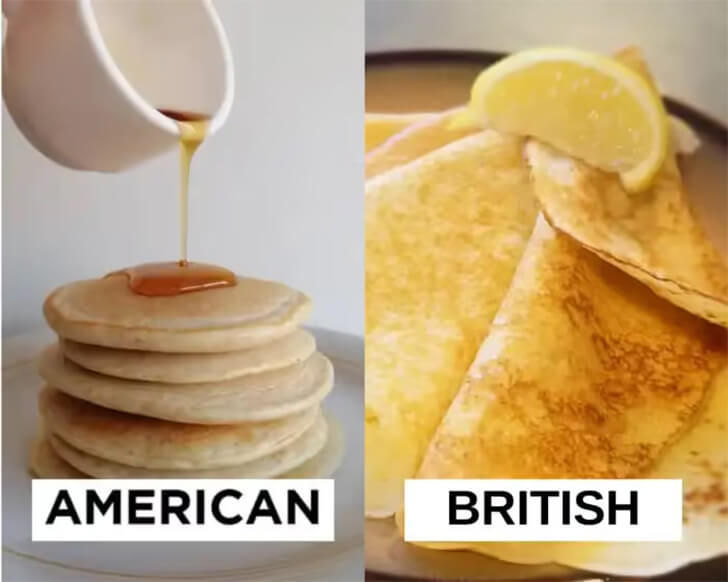
Unlike crêpes, British pancakes are typically served with sugar and lemon juice, and they’re more commonly consumed on Shrove Tuesday. While both versions share core ingredients, the texture and toppings make all the difference.
Popping Pearls Across Oceans
Bubble tea began its delicious journey in Taiwan during the 1980s and quickly captured global hearts. When it arrived in America, this already innovative drink underwent further transformations.
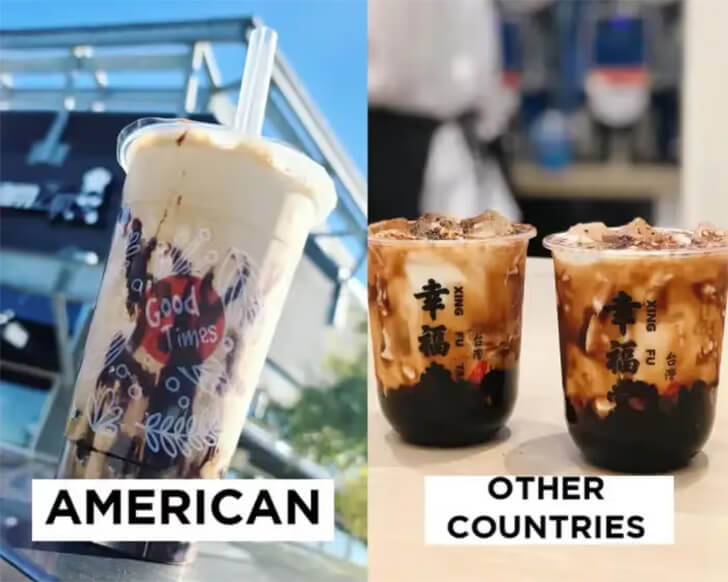
While traditional bubble tea combines brewed tea, milk, and tapioca pearls, the American iteration often leans into dessert territory, resembling a smoothie packed with fruity flavors and sometimes even whipped cream. The tapioca pearls, however, remain constant, offering chewy surprises in every sip. While the essence remains the same, regional tastes shape its flavors and textures.
Hotdogs Across Hemispheres
Ah, the humble hotdog—a cultural icon in America, often grilled and nestled in a bun with mustard and ketchup. Now, let’s hop over to Australia and New Zealand, where hotdogs take a plunge into hot oil. Yep, they’re deep-fried, giving them a crispy outer layer that contrasts the juicy sausage within.
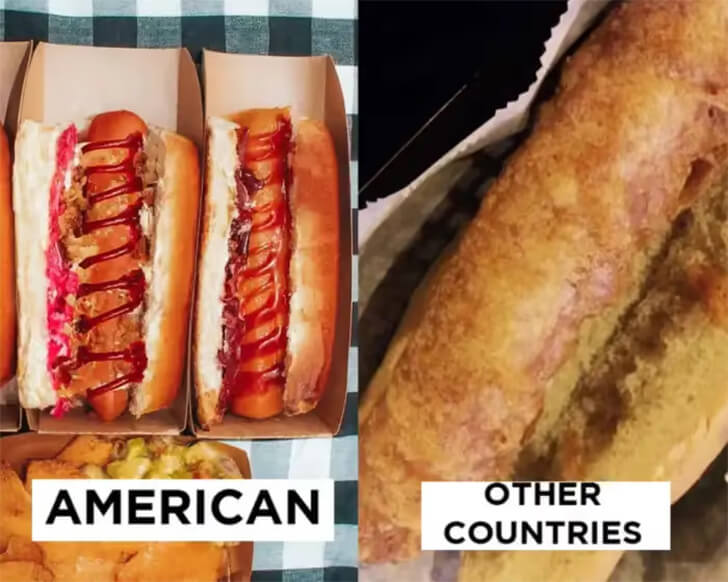
This “battered savory” emerged as an irresistible fairground and takeaway snack, creating an indulgent treat that diverges from its American counterpart. Each style encapsulates the culinary spirit of its nation, making hotdogs a versatile delight.
Cream of the Crop Or The Clear Winner
For Americans, clam chowder is a creamy affair. Laden with potato chunks, clams, and sometimes bacon, its milky base is often thickened with a roux. Its creaminess is a hallmark, particularly in the New England version.

Meanwhile, in other countries like Portugal, “sopa de amêijoas”—a clam chowder—is built on a tomato and garlic broth, leaning more toward a clear base. The preference for a creamy, hearty soup speaks to the colder climates in the U.S., while the lighter versions echo the local flavors and culinary histories of their origin countries.
The Cocoa Conundrum of Sweet Over Sophisticated
American chocolates often lean toward the sweeter end of the spectrum, featuring a higher sugar content and less pronounced cocoa flavor. This contrasts sharply with European chocolates, especially those from Belgium or Switzerland, where a higher cocoa content reigns supreme.
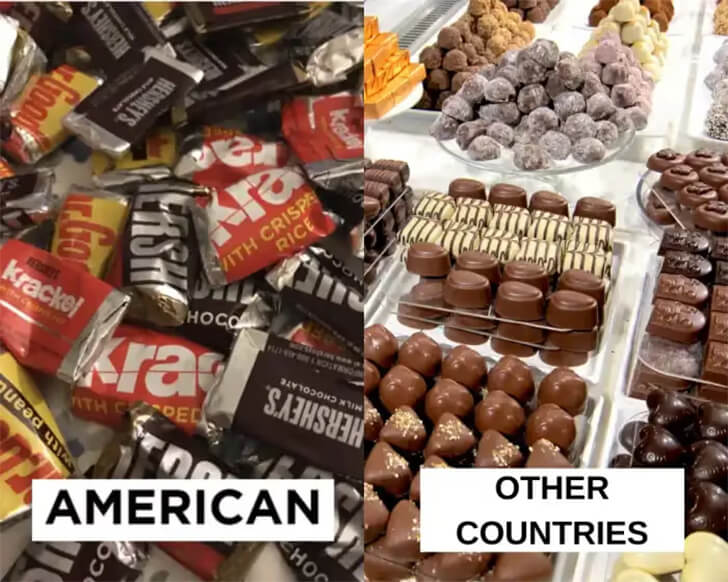
Experts often favor the nuanced flavors of European chocolate, hailing them for their complexity and depth. American varieties, though undeniably popular, are sometimes criticized for their lack of flavor intricacies, with some chocolatiers attributing this to mass production techniques and consumer preferences for sugary delights.
Sour Cream Meets Spice
The sour cream and onion flavor is a chip aisle staple in the United States, born from a love for dips and comfort food. When Lays ventured into India, this classic was renamed “American-style cream and onion” to emphasize its Western roots and perhaps to distinguish it from local flavors.
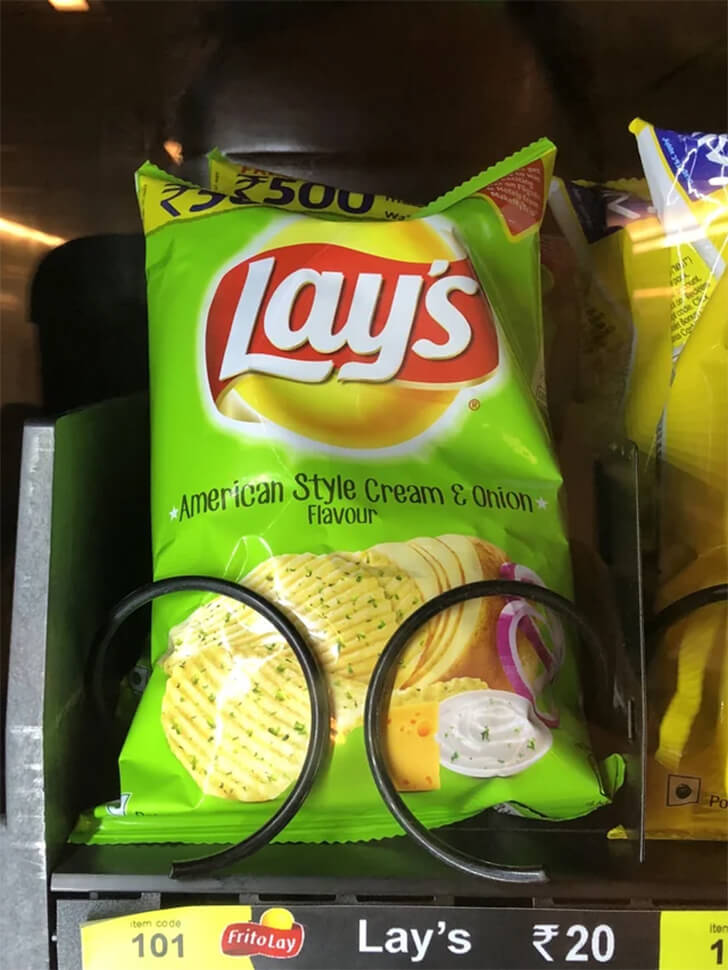
While sour cream itself is less prevalent in Indian cuisine, labeling it “American-style” adds an exotic touch for consumers. Internationally, the flavor has mixed popularity, often overshadowed by regional preferences like prawn cocktails in the U.K. or seaweed in Japan.
The American Size Phenomenon
Yes, portions in America are generally larger than in many other countries, reflecting a culture of abundance and the “more is better” mindset. This spills into packaged goods like mayonnaise jars and sliced bread, often touted as “American size” abroad.
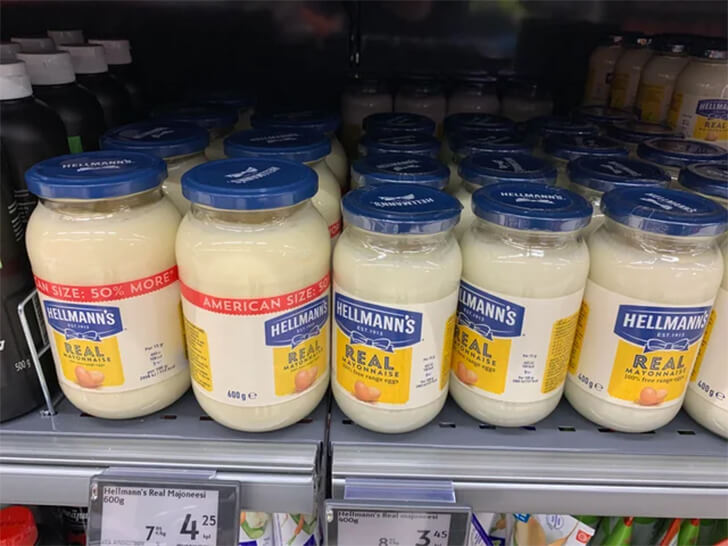
Such labels conjure a sense of generosity, echoing the American penchant for supersized items. It’s not just about satisfying hunger; it’s a lifestyle statement, a manifestation of freedom to choose and consume without restraint. Even globally, “American size” has come to symbolize excess and abundance.
Surprising American Breakfast Myths
In Japan, there’s a misconception that Americans kickstart their day with hotdogs, doughnuts, and coffee. While this might occasionally happen, it’s not the norm. Glazed doughnuts alone pack around 250 to 300 calories, while a typical hotdog in a bun hovers at 250 to 300 calories as well.

Add a cup of black coffee, which contributes only two to 5 calories, and you have a breakfast that totals around 500 to 600 calories. It’s important to remember that breakfast habits vary widely across the United States, and not everyone indulges in this calorie-rich start to the day.
Taste the Rainbow, Taste the Difference
Skittles, the iconic rainbow candy, differs in flavor between the U.S. and the U.K. In the US, the green Skittle is apple-flavored, and the purple one tastes like grape. However, across the pond in the UK, the green Skittle boasts a zesty lime flavor, while the purple one bursts with the richness of black currant.
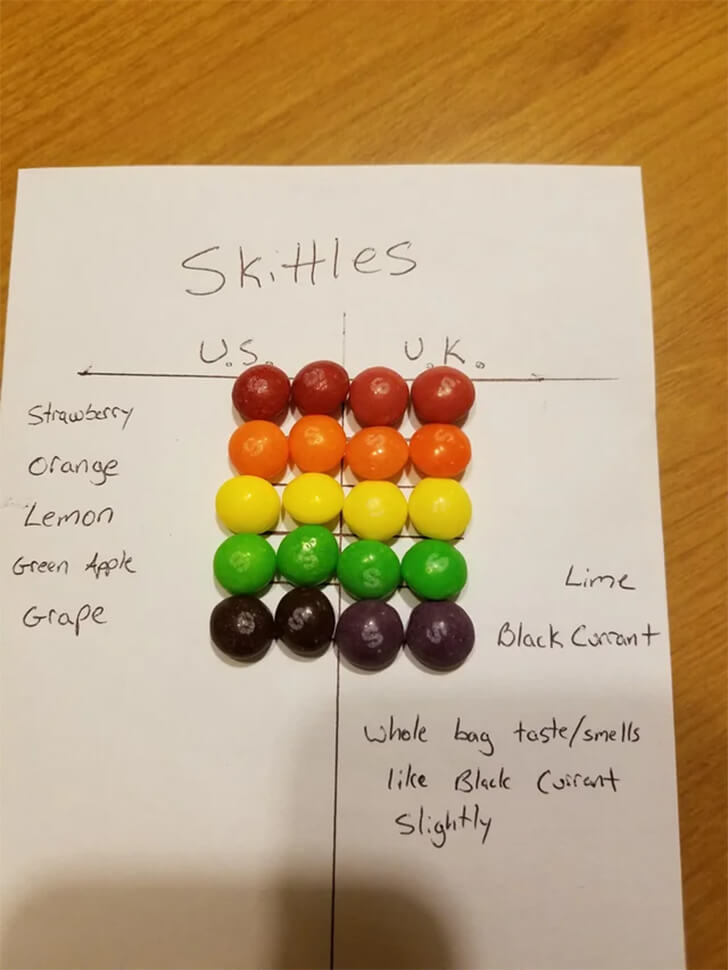
This variation is due to regional preferences and perhaps a desire to cater to different palates. So, while both countries enjoy the same colorful candies, they experience a slightly different taste of the rainbow.
S’more Than You Think
Toasting marshmallows isn’t solely an American pastime. In Germany, you can find an American brand of marshmallows called “Traditional Barbecue Marshmallows,” emphasizing the global appeal of this sweet treat. While marshmallow toasting may have deep roots in the U.S., it’s a delight enjoyed worldwide.

The allure of roasting marshmallows over an open flame transcends borders, bringing people together over a shared love for that perfect, gooey, golden-brown delight, regardless of where they call home. So, whether you’re in Germany or America, the joy of toasting marshmallows knows no borders.
Eddie Rockets Brings Bite of the States
Eddie Rockets, a popular diner in Ireland, offers a menu that’s the closest thing to an American meal experience. Picture this: savoring a Smokestack burger, a half order of crispy fries and onion rings, and washing it down with a decadent brownie milkshake.
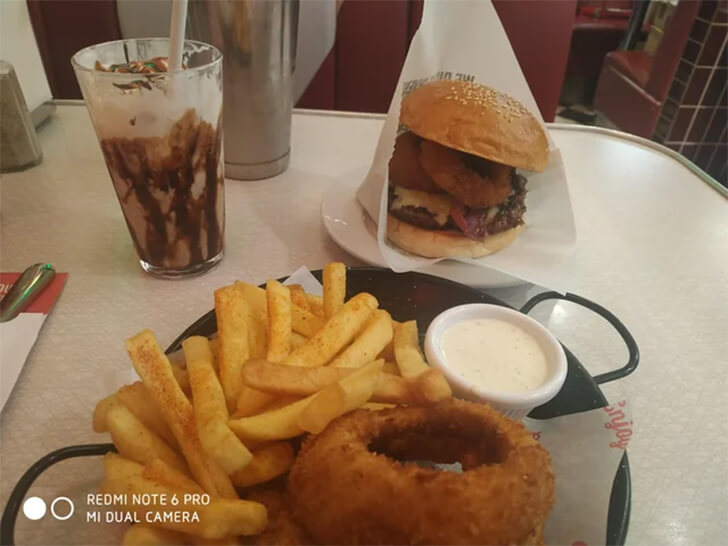
But why does Eddie Rockets serve American-style food? It’s a nod to the love for American diners and their classic fare. The chain aims to recreate that nostalgic experience right in Ireland, giving diners a taste of the U.S.’s beloved comfort food.
Exploring Comfort Food In Chile’s International Aisle
Walmart’s Great Value macaroni and cheese has made its way to the international food aisle in Chile, offering Chileans a taste of this classic American dish. While mac ‘n’ cheese is often associated with the United States, its cheesy pasta goodness has fans worldwide.
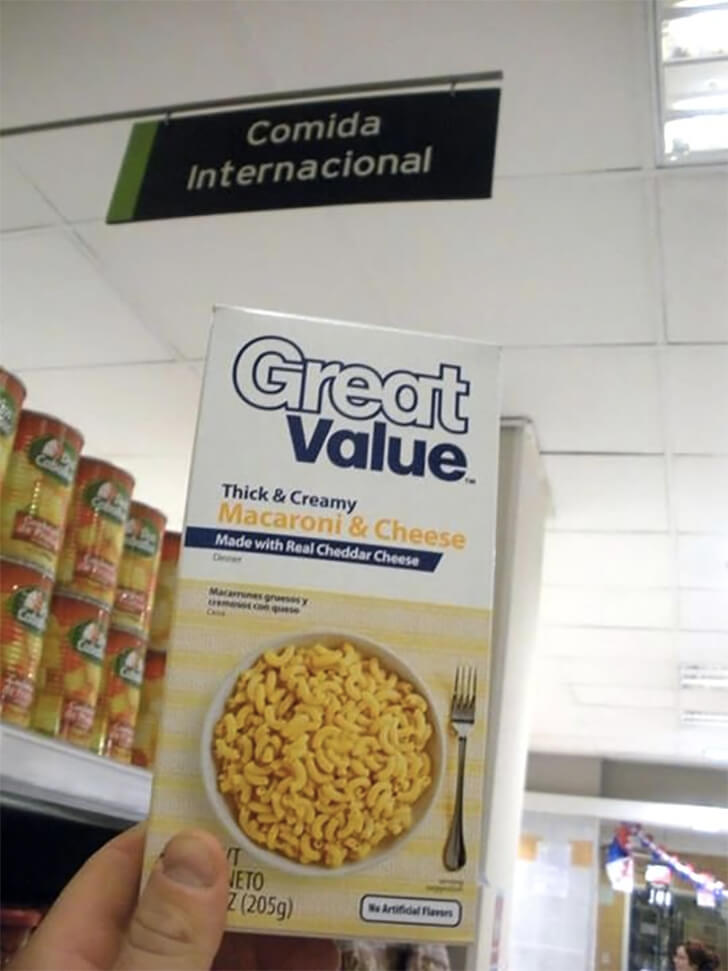
In Chile, similar comfort foods with creamy, cheesy elements are embraced, showcasing the universality of comfort cuisine across borders. So, whether you’re in the US or Chile, indulging in a comforting bowl of cheesy pasta is a delightful experience cherished by many.
Exploring Candy Variations
Here’s a sweet tidbit: American Sour Patch Kids are slightly bigger than their Canadian counterparts. But why the size difference? It’s a curious quirk of candy production.

It’s not unique to Sour Patch Kids; variations in candy sizes exist across the United States and Canada. Factors like regional preferences, production methods, and packaging can all influence candy sizes. So, next time you enjoy a pack of these tangy treats, you might just be experiencing a slightly bigger burst of flavor in the U.S.
Disgust or Delight? The Sweetness Twinkies and Pop-Tarts
In an unexpected turn, Twinkies and Pop-Tarts have earned their place in Sweden’s Disgusting Food Museum. But why the controversy? Some people find these iconic American snacks disgusting due to their high sugar content and artificial ingredients.

Twinkies, for example, contain around 19 grams of sugar per cake, while certain Pop-Tarts flavors can reach 17 grams per pastry. While beloved by many, these treats raise questions about the perception of sweetness and what constitutes “disgusting” in the world of food.

You must be logged in to post a comment Login